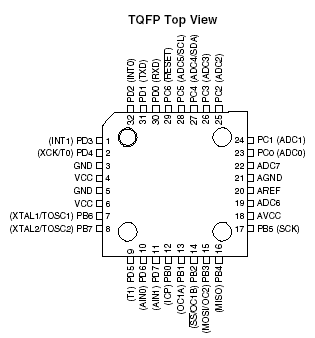Atmega8 Datasheet Na Russkom

The programmer you have programs the ATmega8 through the ISP interface on the device. Here is the pinout of your programmer: You can see the circles and the one square? The square denotes the 1st pin, or MOSI. I think I found the right datasheet to your ATmega8 MCU, please double check the datasheet for the MCU that you have. Extracted from the ATmega8/ATmega8L datasheet found here: You can see that pin 19 (PB5) is the SCK pin. Pin 18 is MISO, 17 is MOSI, 1 is RESET.
These are the pins that connect to the appropriate ISP pins that you can see in the first picture above. So your overall system will be like this: • Have the ATmega8 powered from a reliable DC 5V power source • Ensure the ATmega8 is grounded • Connect the pins of the ISP programmer to the appropriate pins on the ATmega8 • Pull up resistor (~10k) on the RESET pin. This is all you should need to get the programmer to talk to your MCU using your computer. Best of Luck.

The 'circles' and 'squares' are just conventions; in this case the square indicates pin 1. I'm not sure what you mean by 'all inputs are square in my item.' If you look at the ribbon cable connector (at right in the image I added to your question), there is a triangle on the silkscreen that also denotes pin 1. (The red stripe on the ribbon cable is also usually for pin 1, but in the image it is shown backwards. I would trust the silkscreen.) The pinout (also added) shows you the purpose of each pin.
Brittany 21.09.16 17:21 comment2, skachat_igru_novyi_chelovek_pauk_na_android_s_avtozagruzkoi_kesha, 583. Oct 23, 2013 - Atmel designers have decided that having a separate Analog VCC and Ground is the best way of. From the ATMega8 complete datasheet.
Download merchant ship construction da taylor pdf editor. MOSI, for example, is 'Master Out, Slave In.' You can find additional information about this if you research. If you have a digital multi-meter with 'Diode Test' feature, you can use it as a connection tester (Here we it call a 'Beep-Check':D), you will simply find out what pin of the A-side connector is connected to the B-side connector. Learn the order of connections because it is a convention to connect pins of these flat-cables in that way. Next you will have to simply connect MOSI to MOSI, MISO to MISO, SCK to SCK and absolutely the NRST to NRST (as other friends said, it is better to pull-up NRST using a 10K~47K resistor - however the AVR already has this resistor.
It is just for precaution). AND DON'T FORGET THE 'GND' PIN! Every two device with electric link must have common GROUND. I must add and remark something to addition to what my friends, JYelton and Nick said: Please make sure that your ATmega8 (or whatever IC you are using) is powered from the external adapter (+5V) OR from the programmer. Not BOTH OF THEM!!!
Otherwise, you may damage your computer's USB port, or the adapter (or in some cases even the programmer and the microcontroller)!!
My Arduino Uno has a ATMEGA328P-PU microcontroller, and bunch of other stuff on the board. I'd like to program the chip without the Arduino software, and only the minimum of other components. I want to eventually create things without the cost of Arduino, and I want to learn about the other parts on the board and add them back as as needed. I'm comfortable with C and gcc, so I can probably figure out the software part. But what, if anything, besides these two products below, do I need to have in the breadboard with the microcontroller? $ begingroup $ @capcom First google result for 'site:atmel.com atmega typical application' finds. Not only does this application note have a minimal circuit to get the MCU to work, it goes in to great detail on how to connect a programming port, select oscillators, deal with ESD hazards, potential glitches on the reset line, connecting JTAG, PCB layout, and basically everything a beginner needs.